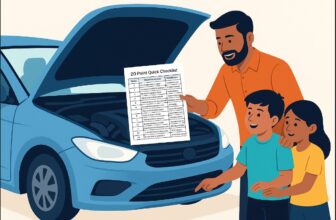India’s car market has changed more in the last three decades than in the 40 years before that. Cars that once dominated Indian roads are now almost extinct. Stricter emission rules, new safety regulations, and consumer preferences shifting toward SUVs have pushed many once-iconic models off the streets.
These cars, however, still carry deep nostalgia. For many families, they were the first car, the first road trip, or the vehicle that defined a generation of mobility. Today, spotting them is rare, often limited to vintage car rallies or enthusiast collections.
Here’s a look at 19 such cars that once had a strong presence in India but have now disappeared.
1. Maruti 800
The Maruti 800 was more than a car; it was a symbol of middle-class aspiration in the 1980s and 1990s. Affordable, fuel-efficient, and easy to maintain, it quickly replaced the bulky Ambassador and Padmini as India’s most popular family car.
After ruling the roads for nearly three decades, it was phased out in 2014 when stricter emission and safety rules made the design outdated. The Alto replaced it as Maruti’s entry-level car, but the 800 remains unforgettable for its role in motorizing India.
2. Hindustan Ambassador
Once known as the “king of Indian roads,” the Ambassador was India’s official government car for decades. Its spacious design and strong build made it popular among politicians and bureaucrats.
By the 2000s, it looked outdated compared to modern cars with power steering, fuel efficiency, and airbags. With BS-IV norms and stricter safety requirements, the Ambassador was finally discontinued in 2014. Today, it survives mainly as a taxi in Kolkata and as a collector’s car.
3. Premier Padmini
If you’ve ever seen Mumbai’s iconic black-and-yellow kaali-peeli taxis from the 1980s and 1990s, chances are it was a Premier Padmini. Compact yet reliable, it served as both a private car and a taxi for decades.
Its production stopped in 2000 as Premier Automobiles failed to modernize. Spare parts became scarce, and stricter emission laws forced taxis to move on to newer models. Today, spotting a Padmini is a rare event in Mumbai.
4. Maruti Zen
Launched in the 1990s, the Maruti Zen was India’s first sporty hatchback. It was compact, responsive, and stylish compared to the boxy cars of its era. Limited editions like the Zen Carbon and Steel gave it cult status.
Maruti discontinued it in 2006 and introduced the Zen Estilo, which never matched the original’s popularity. Enthusiasts still hunt for well-maintained Zens, but on the road, it has almost vanished.
5. Maruti Esteem
The Esteem was one of Maruti’s first successful sedans, widely used in the 1990s and early 2000s. Families loved its comfort, while rally drivers admired its performance. It became a status symbol before Honda City took over.
The Esteem was replaced by the Swift Dzire in 2008. Today, you rarely see one outside old garages or motorsport events.
6. Tata Sierra
The Sierra was India’s first lifestyle SUV, launched in the 1990s. With its three-door design and wraparound rear glass, it looked futuristic compared to the cars of that time.
But its bulky size and lack of refinement limited its appeal. It was discontinued, but its legacy remains strong enough that Tata Motors showcased an electric Sierra concept at Auto Expo 2020. The original, however, is nearly extinct on Indian roads.
7. Mahindra Armada / MM540 Jeep
Before the Bolero became India’s rural workhorse, Mahindra’s Armada and MM540 Jeep ruled the countryside. They were tough, reliable, and capable of handling bad roads.
With time, safety norms, emissions rules, and changing consumer expectations made them obsolete. Mahindra transitioned to the Bolero and later the Scorpio, leaving the Armada and MM540 in history books.
8. Mahindra Classic
Launched in the early 1990s, the Mahindra Classic was a rugged, open-top Jeep loved by off-road enthusiasts. It was India’s closest version of the American Jeep Wrangler.
Production ended in the mid-1990s, but it still has a small following among off-road collectors. On regular Indian roads, though, it has almost disappeared.
9. Hindustan Contessa
Dubbed “India’s muscle car,” the Contessa was based on the Vauxhall Victor from the UK. Its long bonnet and luxury interiors gave it a premium feel in the 1980s and 1990s.
However, it was heavy, fuel-hungry, and lacked updates. With the arrival of modern sedans from Maruti, Honda, and Hyundai, the Contessa faded out. Today, it enjoys cult status among vintage car lovers.
10. Daewoo Matiz
The Matiz was a compact hatchback launched by Daewoo in the late 1990s. Its quirky design and good fuel economy made it popular for a while.
Daewoo’s financial troubles and eventual exit from India ended the Matiz’s run. Very few are still running today, and spare parts are nearly impossible to find.
11. Daewoo Cielo
The Cielo was one of the first premium sedans in India during the 1990s. For many, owning a Cielo was a dream because of its luxury features compared to the Ambassador or Maruti 800.
But poor mileage and Daewoo’s exit from India sealed its fate. It is now almost impossible to spot one outside vintage collections.
12. Opel Astra
The Opel Astra entered India in the mid-1990s as a premium sedan. It offered European styling and comfort at a time when choices were limited.
High maintenance costs, poor after-sales support, and Opel’s gradual exit from India meant it didn’t survive long. Today, the Astra is more of a memory than a car you see on the road.
13. Opel Corsa
The Corsa, available as a hatchback and sedan, had a reputation for being reliable and practical. It appealed to families who wanted something better than a Maruti hatchback.
But Opel’s shrinking presence in India meant spares and service support disappeared. Owners had to abandon the car, leading to its near extinction.
14. Mitsubishi Lancer
The Lancer was one of the most loved sedans in India in the late 1990s and early 2000s. Known for its sporty looks and great driving feel, it built a cult following, especially in South India.
But Mitsubishi failed to update the car or expand its service network. With emission and safety regulations tightening, the Lancer was discontinued. Today, well-kept Lancers are collector’s items.
15. Mitsubishi Pajero
The Pajero was the dream SUV of the early 2000s. Known for its rally success and ruggedness, it became a status symbol for businessmen and celebrities.
But high import costs, poor fuel efficiency, and Mitsubishi’s weak presence in India meant sales slowed down. With BS norms kicking in, the Pajero left Indian showrooms.
16. Hyundai Accent
The Accent was Hyundai’s budget sedan that sold well in the early 2000s. It offered space, comfort, and reliability at a time when sedans were aspirational.
By 2010, the market had shifted toward the Verna and hatchbacks like the i20. Hyundai phased out the Accent, and today it’s rare to see one in good condition.
17. Hyundai Sonata
The Sonata was Hyundai’s attempt at the premium sedan segment. Its “Embera” and “Transform” variants offered luxury features at competitive prices.
But Indians preferred SUVs in that price range. Sales dropped, and Hyundai quietly discontinued the Sonata. It has all but disappeared from the roads now.
18. Ford Ikon
Marketed as the “Josh Machine,” the Ikon was a sporty sedan launched in the late 1990s. It was affordable, stylish, and fun to drive, making it popular among young professionals.
But Ford’s limited network and rising competition made it difficult to sustain. Even before Ford’s 2021 exit from India, the Ikon had long disappeared.
19. Chevrolet Optra
The Chevrolet Optra entered India in the mid-2000s as a premium sedan. It gained attention for its comfort and refinement.
However, Chevrolet’s sudden exit from India in 2017 left Optra owners stranded. Without service support or spare parts, the Optra quickly disappeared from Indian roads.
Timeline: Once Popular Cars You Rarely See in India
| Car Model | Launch Year (India) | Peak Popularity | Reason for Disappearance |
|---|---|---|---|
| Maruti 800 | 1983 | 1980s-2000s | Replaced by Alto, outdated under BS-IV/BS-VI norms |
| Hindustan Ambassador | 1957 | 1960s-1990s | Outdated design, failed modernization, BS norms |
| Premier Padmini | 1964 | 1970s-1990s | Lack of updates, emission rules, phased out taxis |
| Maruti Zen | 1993 | Late 1990s-2000s | Discontinued in 2006, replaced by Estilo/WagonR |
| Maruti Esteem | 1994 | 1990s-2000s | Replaced by Swift Dzire, changing market focus |
| Tata Sierra | 1991 | 1990s | Niche appeal, discontinued, safety/emission rules |
| Mahindra Armada / MM540 | 1980s-1990s | 1980s-1990s | Outdated design, replaced by Bolero/Scorpio |
| Mahindra Classic | 1992 | 1990s | Limited market, discontinued mid-1990s |
| Hindustan Contessa | 1984 | 1980s-1990s | Fuel hungry, outdated vs. modern sedans |
| Daewoo Matiz | 1998 | Late 1990s-2000s | Daewoo’s India exit, lack of service support |
| Daewoo Cielo | 1995 | 1990s | Poor mileage, Daewoo bankruptcy & exit |
| Opel Astra | 1996 | Late 1990s | High maintenance, Opel exit from India |
| Opel Corsa | 2000 | Early 2000s | Opel withdrawal, spare parts issues |
| Mitsubishi Lancer | 1998 | 2000s | Lack of updates, Mitsubishi decline in India |
| Mitsubishi Pajero | 2002 (official) | 2000s-2010s | Expensive, fuel-inefficient, emission rules |
| Hyundai Accent | 1999 | 2000s | Replaced by Verna, fading sedan demand |
| Hyundai Sonata | 2001 | 2000s | Decline of premium sedans, SUV preference |
| Ford Ikon | 1999 | 2000s | Competition, phased out before Ford exit |
| Chevrolet Optra | 2003 | 2000s | Chevrolet’s exit from India in 2017 |
Why These Cars Disappeared
- Changing Preferences: Indians shifted from sedans and hatchbacks to compact SUVs and MPVs.
- Stricter Rules: Bharat Stage emission norms and new safety regulations forced older designs off the market.
- Global Exits: Brands like Daewoo, Opel, Mitsubishi, Chevrolet, and Ford exited India, leaving their models unsupported.
- Value Shift: SUVs became the new status symbol, pushing sedans and older cars into irrelevance.
Conclusion – Cars That Defined India’s Roads but Have Now Faded Away
These 19 cars shaped India’s motoring journey across different eras. From the Maruti 800 that put India on wheels to the Pajero that defined aspiration, each one carried cultural significance. Today, they live on mostly in memories, vintage garages, and car enthusiast clubs.
Their disappearance shows how quickly the Indian car market adapts. SUVs, electric cars, and hybrids are now the new mainstream, but for many, these classics will always hold a special place.





